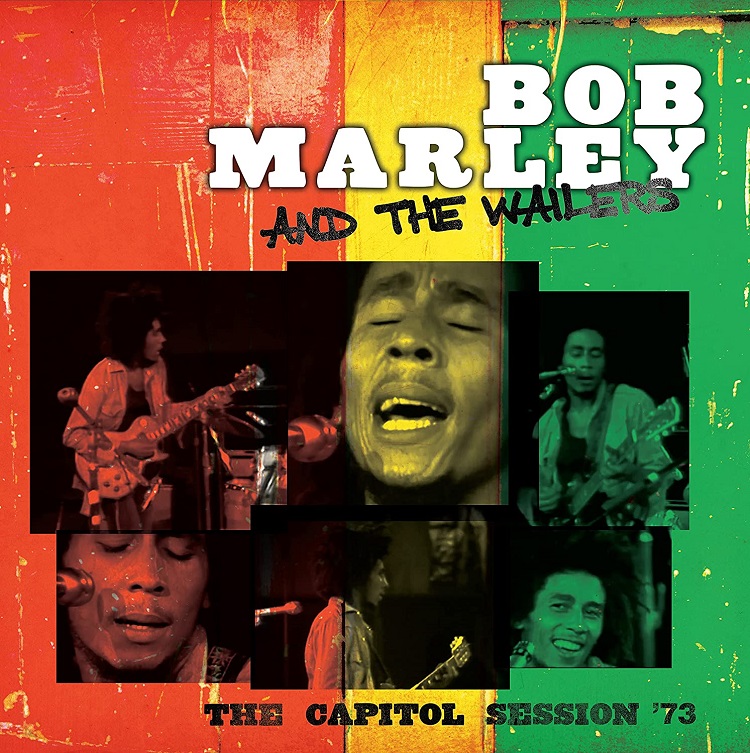
Bob Marley and The Wailers’ The Capitol Session ’73 was lost to history until researcher Martin Disney unearthed a three-minute clip while searching for footage for a documentary project. This initial detective work led to a cache of seven hours of unedited footage. Disney, along with film editor Tim Dollimore, condensed and restored the footage into a 60-minute concert that comprises The Capitol Session ’73.
The Wailers had been together for 10 years by 1973. Despite being praised by the rock press, and having the PR capabilities of Island Records behind them, the band’s first two releases, Catch a Fire and Burnin’ had failed to make a dent in the U.S. charts. The Wailers opened for Sly and the Family Stone on their 1973 tour, and were dropped after a few months, largely due to poor audience response. The Wailers’ tour manager Lee Jaffe said the audiences just sat there, not quite knowing what to make of the band. (The scenario echoes the debacle the occurred when Prince opened for the Stones in ’81, but ‘70s fans were more reserved about their displeasure.) Shortly after being fired from the tour, Shelter Records founder/ producer Denny Cordell hooked up with group and invited them to film and record a studio session. The band taped at Hollywood’s Capitol Studios in October 1973.
The Capitol Studio Session version of Wailers featured Bob Marley vocals/guitar, Peter Tosh on vocals/guitar, Joe Higgs (filling in for Bunny Wailer) on percussion/backing vocals, Earl “Wya” Lindo on keyboards, and brothers Aston and Carlton Barrett (bass and drums, respectively).
The 12-song set (sans an official “audience”, but with occasional cheers from the studio peanut gallery) starts with Tosh singing “Can’t Blame the Youth” with Marley on background vocals and the slightest keyboard flourish by Lido near the end. Marley takes lead vocals on the funky and slower paced “Rastaman Chant”. Marley and Higgs play congas and Tosh steel drum to strengthens the sound. On “Slave Driver” Tosh’s Wah-Wah pedal accents the perfect synchronicity of voice and rhythm, and “Burnin’ and Lootin’” is as topical now as it was when it was first written.
“Midnight Raver” brings on a hypnotic groove with funky background harmonies and Lind’s Hammond organ, as the session picks up steam. Followed by “Stop That Train” and the chugging bass and percussion of “No More Trouble”and three soon to be iconic songs. The buoyant “Stir It Up” has Aston Barrett’s bass quite low the mix, so the overall effect is a bit different than what we usually hear. The head-bobbing tempo of “Kinky Reggae“ reminds you that the Barrett brothers rhythm section can do no wrong. Unsurprisingly, the anthem “Get Up Stand Up” ends the session, with co-writers Tosh and Marley sharing vocals, and the energy level of the performance skyrockets just as the session ends.
The Capitol Session ’73 gives us a taste of what was to come just a few years later, as Marley and, to a lesser extent, Tosh became legendary figures in popular music. Sadly, only one member of the ‘73 Session line-up is still with us today. Aston “Family Man” Barrett toured with the Wailers is the last surviving member of the ’73 Wailers’ line-up. He toured with the reconstituted version of the band until several strokes sidelined him in 2017.
Bob Marley and the Wailers – The ‘73 Capitol Session is now available from Tuff Gong/Mercury. You can purchase it as a 2 LP set, a DVD/CD set, digital download, or a CD. The DVD features “Duppy Conqueror” and “Rastaman Chant”, two songs you won’t find on the CD-only version. Record collectors have a choice of 2 LP sets – one with a green marble vinyl and the other on red, yellow, and green “Rasta Swirl” vinyl. The concert is available for streaming on Amazon Prime’s Coda Collection music documentary channel.
Bob Marley and the Wailers – The ‘73 Capitol Session is a glimpse into a music legend on the cusp of his/their fame. All these decades later, Bob Marley and the Wailers are just a memory for geezers, Marley is a folkloric figure to young hipsters, and simply a T-shirt from Target to non-musical younger folks. This restored footage gives historical context to the legend and brings it into focus for those of us who weren’t around for the band’s 1970s heyday.